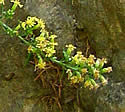Solidago sciaphila (Cliff Goldenrod)
| Also known as: | Driftless Goldenrod, Shadowy Goldenrod |
|---|---|
| Genus: | Solidago |
| Family: | Asteraceae (Aster) |
| Life cycle: | perennial |
| Origin: | native |
| Habitat: | part shade, sun; on or near dolomite or sandstone cliffs, outcrops, bluffs |
| Bloom season: | August - September |
| Plant height: | 18 to 30 inches |
| Wetland Indicator Status: | none |
| MN county distribution (click map to enlarge): |  |
| National distribution (click map to enlarge): |  |
Pick an image for a larger view. See the glossary for icon descriptions.
Detailed Information
Flower: 


![[photo of flowers]](/udata/r9ndp23q/pd/solidago-sciaphila-79-1-t.jpg) Clusters are somewhat open, few flowered, forming in the upper leaf axils of the stem. The yellow flowers are up to ¼ inch tall and face out from the branches, the central disk small in relation to the 6 to 10 rays (petals) that surround them. The floral bracts are in 3 or 4 layers, pressed flat and unequal in size.
Clusters are somewhat open, few flowered, forming in the upper leaf axils of the stem. The yellow flowers are up to ¼ inch tall and face out from the branches, the central disk small in relation to the 6 to 10 rays (petals) that surround them. The floral bracts are in 3 or 4 layers, pressed flat and unequal in size.
![[photo showing branching]](/udata/r9ndp23q/pd/solidago-sciaphila-79-25-t.jpg) Branches (peduncles) in the axils often extend a few inches, beyond the associated leaf, with small leafy bracts alternating up the stem. As a plant matures it can turn from a slender, columnar, spike-like cluster to a thicker, more densely packed wand-shaped panicle.
Branches (peduncles) in the axils often extend a few inches, beyond the associated leaf, with small leafy bracts alternating up the stem. As a plant matures it can turn from a slender, columnar, spike-like cluster to a thicker, more densely packed wand-shaped panicle.
Leaves and stems: 


![[photo of lower leaves]](/udata/r9ndp23q/yellow/cliff-goldenrod_0915_163937-t.jpg) Leaves are mostly basal. Basal and lower stem leaves have spatula-shaped blades that taper into a narrowly winged stalk, 2½ to 6 inches long, smooth on both surfaces except for fine hairs along the shallow toothed edges (ciliate).
Leaves are mostly basal. Basal and lower stem leaves have spatula-shaped blades that taper into a narrowly winged stalk, 2½ to 6 inches long, smooth on both surfaces except for fine hairs along the shallow toothed edges (ciliate).
![[photo of leaves]](/udata/r9ndp23q/pd/solidago-sciaphila-8709-22-t.jpg) Leaves become progressively smaller and narrower as they ascend the stem, down to 1 inch long near the flower cluster, more lance-elliptic, tapered equally at both ends, mostly stalkless and toothless, Stems are mostly unbranched and smooth except for very fine hair in the flower cluster, and tend to flop over, arching or becoming prostrate.
Leaves become progressively smaller and narrower as they ascend the stem, down to 1 inch long near the flower cluster, more lance-elliptic, tapered equally at both ends, mostly stalkless and toothless, Stems are mostly unbranched and smooth except for very fine hair in the flower cluster, and tend to flop over, arching or becoming prostrate.
Notes:
Cliff Goldenrod's range is restricted to the Driftless Area (called that because it escaped glaciation and the debris, a.k.a. “drift”, left behind by the last glacier) in Minnesota, Wisconsin, Iowa and Illinois. It is considered rare in all four states. In Minnesota it inhabits the limestone bluffs of our southeastern counties with only one specimen having been collected as far north as the limestone outcrops along the Kettle River in Pine county. While still abundant within local areas, populations appear to be declining and are at risk from woodland expansion (due to lack of fires), recreation (primarily rock climbing) and the ever growing risk of competition from non-native invasive species. The Minnesota DNR listed it as a Special Concern species in 1984. It can appear somewhat similar, especially when not in flower, to Showy Goldenrod (Solidago speciosa) that may be present in the same cliff habitats, but Cliff Goldenrod's lower leaves are clearly toothed whereas Showy's are always toothless. Cliff Goldenrod is also similar in appearance to Hairy Goldenrod (Solidago hispida) which is hairy all over where Cliff Goldenrod is essentially hairless.
Native Plant Nurseries, Restoration and Landscaping Services ↓
More photos
Photos by K. Chayka and Peter M. Dziuk taken at Whitewater State Park and WMA, Winona County.
Comments
Have you seen this plant in Minnesota, or have any other comments about it?
on: 2021-08-28 15:41:19
Clusters of plants on the rock outcrop. Hairy goldenrod was also found.







 Cliff Goldenrod plant
Cliff Goldenrod plant more plants
more plants mature plant, flopped over
mature plant, flopped over cliff habitat
cliff habitat